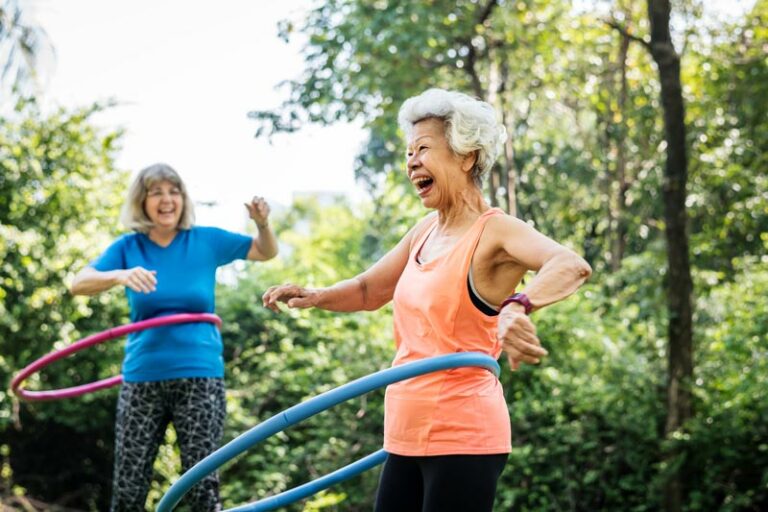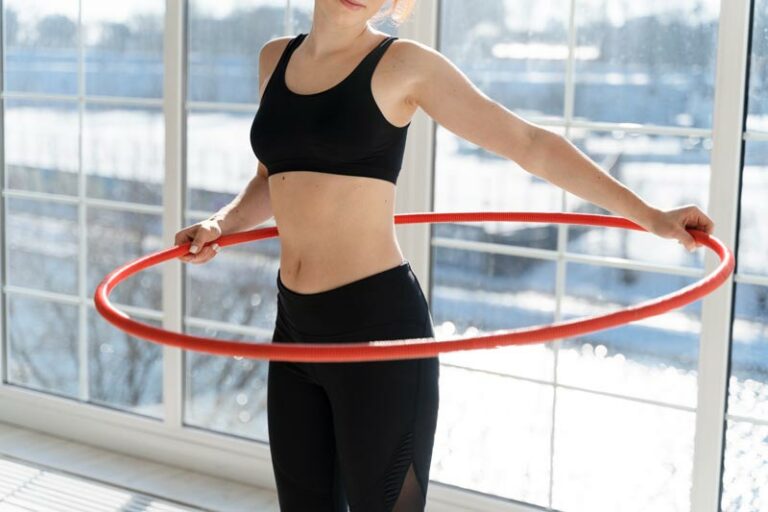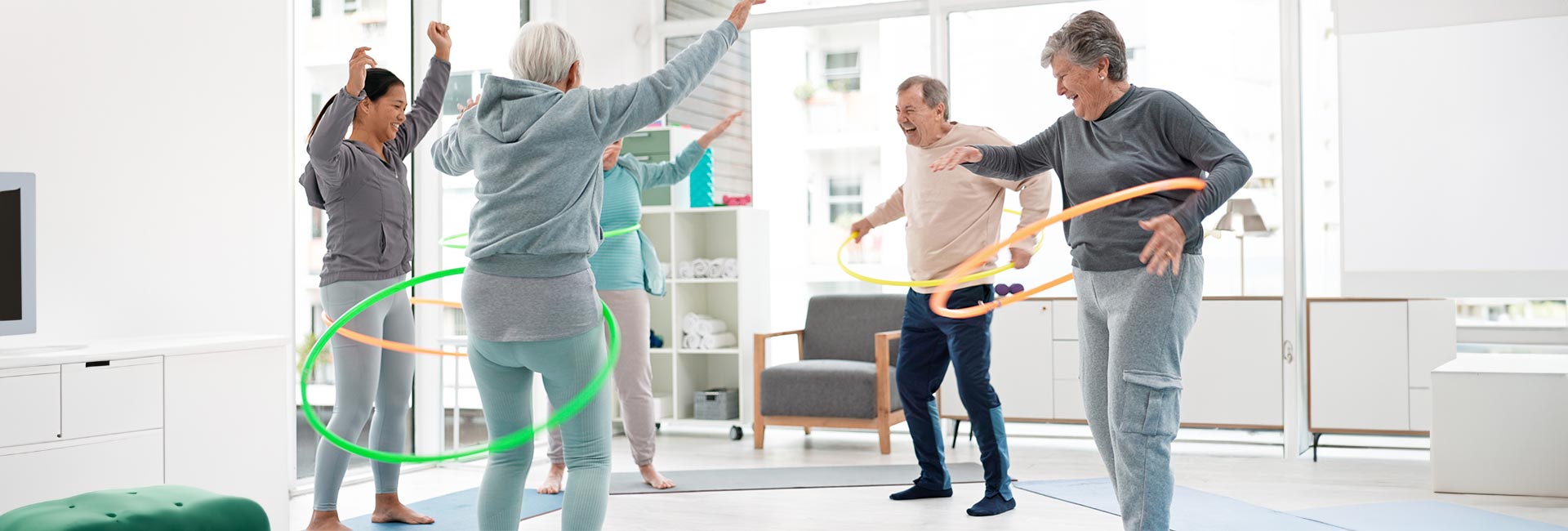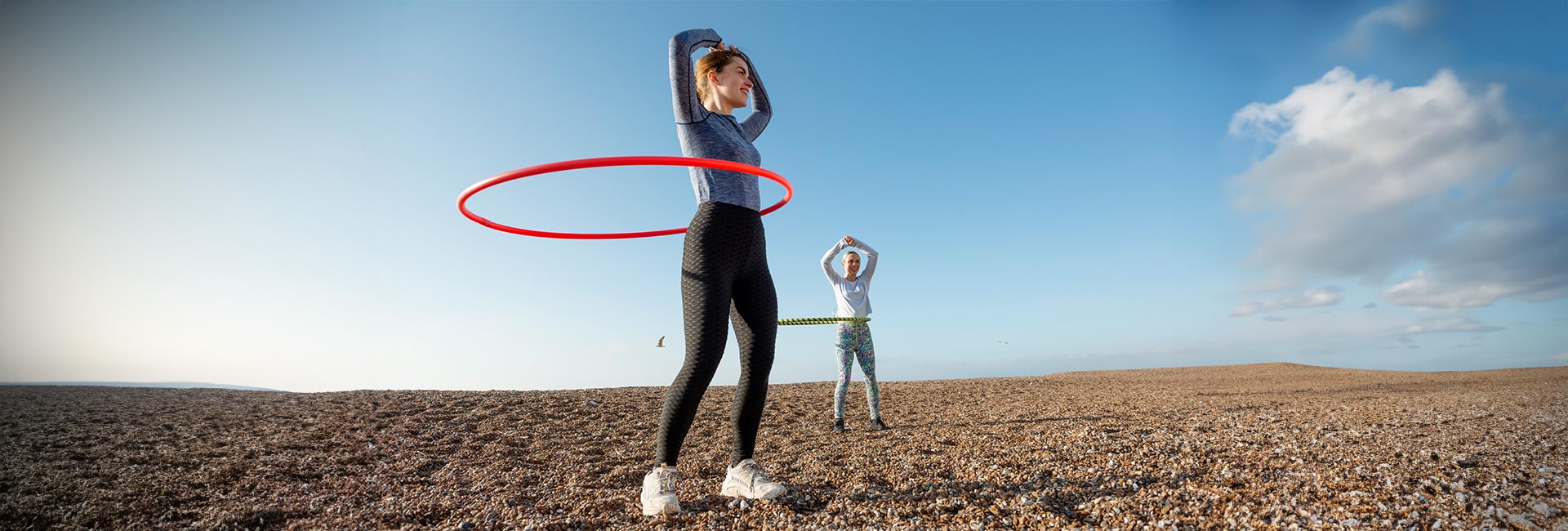Are you looking for a new and exciting whole-body exercise with a touch of nostalgia? What about a low-impact activity that allows you to be creative and expressive? Then, hula hooping might be your new favorite fitness routine!
What is hula hooping?
At some point during your childhood, you may remember playing with a hula hoop; a round, hollow, plastic object made in a variety of sizes, colors, and weights. Often, kids compete to see who could keep the hoop rotating around their waist the longest. Hula hooping involves moving a hoop around your body in a rhythmic fashion. While waist hooping is the most common type of hula hooping, it is common to spin a hoop around many areas of the body. Types of hooping include on-body and off-body techniques. On-body moves are when the hoop moves around a body part including waist, chest, shoulders, knees, etc. Conversely, off-body tricks include tossing, flipping, or catching a hoop.4 Transitioning between on-body and off-body tricks offers versatility and creativity, making exercise fun!
Hula hooping to support a healthy lifestyle
According to the department of health, “150 minutes of moderate-intensity activity or 75 minutes of vigorous activity per week is recommended for overall health.”5 Depending on the size, weight and speed of movement, hula hooping can fall into either of these categories and be a great alternative exercise routine for maintaining a healthy lifestyle.
Hula hooping — a low impact exercise
As we age, higher impact activities such as running, jumping, or climbing may not be well tolerated or accessible due to stress on joints or pain. Conversely, low impact exercises are less stressful on joints, and include activities such as walking, bicycling, swimming.1 Depending on what your fitness goals are, you can determine which type or combination of exercises may be the most beneficial for you. Hula hooping is a low impact activity which is available to all age groups and fitness levels. However, if you desire to build muscle strength or increase muscle size, then lower impact activities might not be as effective, as they do not adequately load the tissue with weight.

Hula hooping for cardio fitness
The constant movement required to keep a hula hoop steady around the waist or on other body regions causes the heart rate to rise in response to physical demands. Heart and lung health improve through regular participation in aerobic exercise which helps improve the oxygen flow in the body.8 In just 30 minutes of hula hooping, on average, women can burn 165 calories, while males can burn 200 calories.5

Burning calories helps to reduce cholesterol and fat stored in the body leading to weight loss and improved overall health. In a six-week study of women using weighted hula hoops, participants’ waist circumference reduced on average by 3.4 cm.2 While this study focused on weighted hoops, standard hoops can provide similar benefits, depending on the duration and speed the hoop moves.
Hula hooping for core strengthening
The rhythmic movement of on-body hooping requires repetitive contractions of abdominal muscles. Core strength is necessary to keep the hoop from falling below the waist and with practice, endurance for these muscles will improve. In addition, posture is an important factor in keeping the hoop in a level position around the waist. If you lean forward or backward too far, the hoop will begin to move in a diagonal direction and will likely fall to the ground. Shifting weight from side to side or front to back while hooping requires maintaining balance, which is helpful for longevity and for decreasing fall risk.
Hula hooping to relieve low back pain
Low back pain is a widespread problem in our sedentary society, particularly for people who have a desk job. Core strengthening is an important component of mitigating low back pain. Hula hooping provides an efficient and low-impact alternative to more traditional core exercises such as crunches. Greater core strength provides support for the lower back which protects structures in the lower back from injury.7 The circular motion of hula hooping provides excellent lubrication of joints in multiple planes which is helpful for overall joint health.
Hula hooping to improve flexibility and coordination
The variety of hula hoop moves provides gentle movement in all body regions. Gentle stretching of muscles and joints improves flexibility allowing more freedom of movement. Moving through the entire range of motion of a joint provides nutrition and keeps joints healthy. Moving from one hoop-move to another or transitioning from on-body to off-body requires smooth, coordinated movement. Having adequate flexibility and coordination is necessary for many activities of daily living such as reaching and lifting something from a high shelf or squatting to pick something up from the floor.

Hula hooping for mental health
Have you ever tried to hula hoop with a frown on your face? It is challenging to hoop without a smile! Hooping brings out the nostalgia of childhood combined with the positive benefits of physical activity. Aerobic exercise increases blood flow to the brain and physiologically helps to reduce the release of stress chemicals in the body. Improved cognitive function and self-esteem are commonly associated with exercise. Hooping with others provides social interaction and freedom of movement which helps to elevate mood and alleviate depressive symptoms.6
Tips for getting started hula hooping:
- Choosing the right hoop size and material:
-
- Waist hooping: when first starting out, choosing a larger hoop will be easier to react to get the rhythm and coordinate movements keeping the hoop up. Measuring the diameter of the hoop from your navel to the floor or larger is a great starting size. A hoop that is slightly heavier will also improve success with maintaining the hoop height. Hoops that are made of high-density polypropylene are more durable and heavier than other hoop materials making them great for beginners.
- Off-body hooping: a smaller sized hoop with be easier to use for tossing, catching or transitioning from off-body to on-body. A hoop that is 35-inch diameter or less and made with polypropylene will be a great starting hoop for off-body moves. This type of hoop will move faster due to the light material and smaller size.
- Warm up and cool down:
-
- Before any type of exercise, it is important to include a warm-up in your routine to prepare your body for movement. It is recommended to start with waist hooping or a series of dynamic stretches to help prevent injury. A cool down at the end of a workout is important to safely bring your heart rate down to a resting level and gently stretch muscles to limit muscle soreness.
- Picking up your hoop:
-
- Inevitably, you will end up dropping your hoop on the ground. Picking up your hoop by bending your knees to squat or sliding the hoop over the top of your foot and lifting it to your hand will decrease stress on the lower back and other joints for injury prevention.
- Choosing a place to hoop:
-
- You can hoop just about anywhere, but to set yourself up for success, it is best to choose an area without a lot of furniture or low ceilings. Outside in a park or in your backyard are great places to practice tossing your hoop, or perhaps juggling.
- Hydration:
-
- Aerobic exercise burns calories and causes you to sweat which can lead to dehydration. Taking breaks during exercise to rehydrate is important to be able to keep fueling your body to continue exercising.
- Waist hooping:
-
- Start with using a hoop that is appropriate for your height as described previously. While standing up straight with one foot staggered in front of the other, step inside the hoop and hold it in both hands at waist height. Move the hoop forward and hold it horizontally so the back of the hoop is in contact with your lower back. Using momentum, move the hoop horizontally to either the left or right and begin moving your hips forwards and backwards with a slight rotation towards the direction the hoop is spinning. Keep repeating the hip motion as the hoop circles around your body.
- Have FUN!
-
- Most importantly, have fun with it! Don’t get discouraged if you aren’t able to waist hoop right away. Just like any skill, hooping takes practice to get better. Enjoy the journey!
For more tips and tutorials, check out Deanne Love on YouTube.

Try PT today!
As physical therapists, we know the importance of movement for overall health and well-being. If you’re struggling to get moving, our experts are here for you.
References
- Bedosky, L., Upham, B., Asp, K., Migala, J., Garone, S., Bedosky, L., … Millard, E. (n.d.). Low-impact workouts: What they are, health benefits, and getting started. Retrieved from https://www.everydayhealth.com/fitness/low-impact-workouts/guide/
- McGill, S. M., Cambridge, E. D., & Andersen, J. T. (2015). A six-week trial of hula hooping using a weighted hoop: effects on skinfold, girths, weight, and torso muscle endurance. Journal of strength and conditioning research, 29(5), 1279–1284. https://doi.org/10.1519/JSC.0000000000000653
- Vallie, S. (2022, August 12). Are hula hoops good exercise? studies indicate yes. WebMD. Retrieved from https://www.webmd.com/fitness-exercise/what-to-know-about-hula-hoops-for-exercise
- Davis, J. (2021, July 24). Hula-hoops are trending, but it’s not your childhood version. CNN. Retrieved from https://www.cnn.com/2021/07/24/health/hula-hoops-fitness-trend-tiktok-trnd-wellness/index.html
- Laskowski, E. (2021). Do weighted hula hoops provide a good workout or are they just a gimmick. Retrieved from https://sportsmedicine.mayoclinic.org/news/do-weighted-hula-hoops-provide-a-good-workout-or-are-they-just-a-gimmick/#:~:text=Hula%20hooping%20can%20provide%20similar,30%20minutes%20of%20hula%20hooping.
- Sharma, A. (2006). Exercise for mental health. The Primary Care Companion For CNS Disorders, 8(2). doi:10.4088/pcc.v08n0208a
- Kiatkulanusorn, Sirirat & Luangpon, Nongnuch & Bhornluck, Paepetch & Sobhon, Prasert. (2020). Effects of Hula Hooping Exercise on Lumbar Stability Level and Transversus Abdominis Function in Asymptomatic Individuals with Poor Lumbar Stability. Journal of Exercise Physiology Online. 23. 1-14.
- Lindberg, S. (2019). Want a fun workout? 8 reasons to give hula hooping a try. Retrieved from https://www.healthline.com/health/exercise-fitness/hula-hoop-benefits#1

